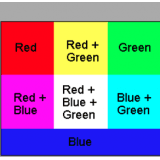In this lab, you can explore the refraction of light through a rectangular block (you can modify its refraction index). The light is emitted by the red dot, which is in air. The light strikes the side of a rectangular block.
LAB
The light source can either be the red dot in medium 1 or the purple dot in medium 2. In either case, the light is incident on the interface between the two media at the position of the green dot, which is fixed.
LAB
This lab builds of the lab titled, 'Refraction and the role of time'.
LAB
Let's say you have two points, and you want the light to travel from one point to the other. In this simulation, by the way, the first point is colored red and the other point is colored purple.
LAB
This lab shows a marching band model for refraction. We're looking at an overhead view of five rows of the marching band. When the band moves from one surface (say, a parking lot) to a different surface (say, a grassy field), the speed of the marchers can change.
LAB
In this lab, you can explore refraction with a lens. You can modify the focal length, height, and position of the object and observe the image formed through refraction.
You can choose between a 'converging' and 'diverging' lens.
How does the height of the image change?
LAB
This lab builds off from the lab titled, "Mirrors and time (the role of time in image formation".
LAB
This lab builds on lab about ray diagrams and image formation using a mirror. In that simulation, it is not clear that time has any role to play in image formation.
LAB
In this lab, you can explore ray diagrams for different types of mirrors. Use the sliders to vary the object position, height, and focal length of the mirror. Observe the changes in the image formed as you do this.
Does the position change?
Does the height change?
LAB
Additive color mixing shows how different colors of light combine to make another color. This is how computer monitors and color TVs make their colors.
LAB









